Movie review: Three foreign animated films from 2017-2019
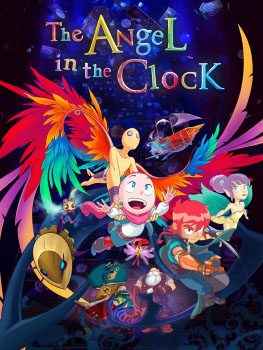 Three foreign animated film reviews!
Three foreign animated film reviews!
White Fang, and
The Bears' Famous Invasion of Sicily.
All of these films successfully blend 3D and 2D animation in their own different styles.
White Fang is the most 3D, applying a brush-like texture to characters to create a 2D, painted look.
The Angel in the Clock (2017)
This 90-minute Mexican animated film (El ángel en el reloj) was produced by Fotosíntesis (a fairly young studio), directed by Miguel Ángel Uriegas, and co-written by the director with Rosana Curiel.
The main character is Amelia, a young girl with cancer, wanting her life to return to normal. Obsessed with the passage of time and how her parents never seem to have enough of it, she removes the batteries from all the clocks in the house, and wishes that time would stop. Overheard by Malaki, a sympathetic time angel, Amelia is brought to a magical sky world of clocks, castles and floating islands. When a demonic entity named Timeless tricks Amelia into giving away a special gemstone, she must embark on a quest before her time runs out.
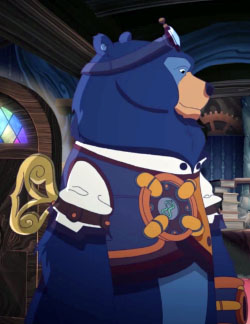 What initially attracted me to this were some images featuring a bear. His name is Balzac, he's kinda chonk, has a large clockwork key sticking out of his back, and is some kind of engineer. Sadly his role is brief; he delivers a bunch of exposition, and we don't see any other major animal characters for the rest of the film.
What initially attracted me to this were some images featuring a bear. His name is Balzac, he's kinda chonk, has a large clockwork key sticking out of his back, and is some kind of engineer. Sadly his role is brief; he delivers a bunch of exposition, and we don't see any other major animal characters for the rest of the film.
There are also a pair of little flying sprites called Here and Now, useless sidekicks with spheres for heads. Later, Amelia is joined by an adventurous youth named Captain Needle. He's got a flying ship, which is totally cool, but he slows down the plot for a while.
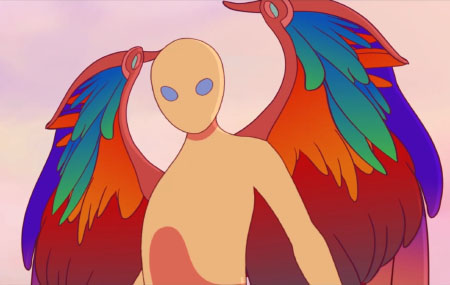 On the plus side, the animators put lots of detail into the backgrounds! Clocks, gears, and bright colours abound; this was definitely drawn with love. I really like the angel Malaki's design, he (they?) is/are androgynous, silent, and a comforting presence.
On the plus side, the animators put lots of detail into the backgrounds! Clocks, gears, and bright colours abound; this was definitely drawn with love. I really like the angel Malaki's design, he (they?) is/are androgynous, silent, and a comforting presence.
This film was made for a specific group: young Spanish-speaking children being treated for (or recovering from) cancer. Death is not a huge thing in the film, though it does have its dark moments. The inevitability of dying is mentioned in passing, in a basic, matter-of-fact way. Mostly the story is about hope, time, and memory, and is an adventurous romp.
Before I wrote this review, I watched the Spanish version with English subtitles. I didn't think an English dub existed - but apparently one has been made! It may be available on Disney+ or Vimeo. IMDB gives it a score of 6.4, based on 110 votes. Story-wise I thought it was just OK, nothing special, but then, I'm way, way older than the target audience. I enjoyed the angel and the background designs the most.
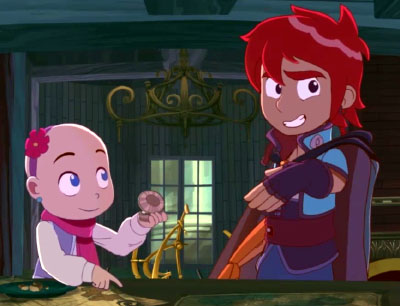
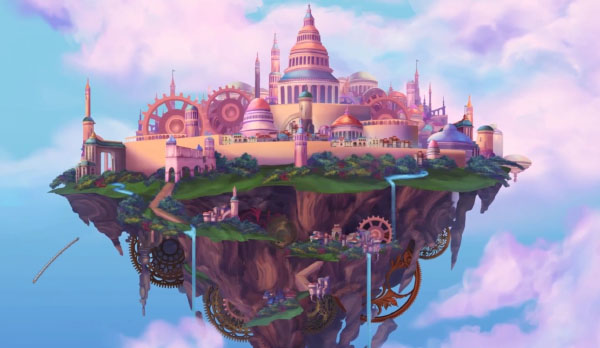
White Fang (2018)
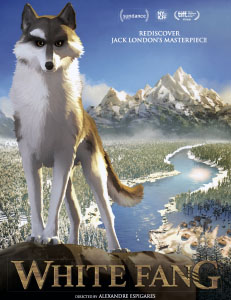 This is an 85-minute computer-animated film (Croc-Blanc) produced in France-Luxembourg by Superprod Animation and other studios, directed by Alexandre Espigares and written by Philippe Lioret, Serge Frydman and Dominique Monféry. It's a very modified adaptation of Jack London's 1906 book. (More on this later.)
This is an 85-minute computer-animated film (Croc-Blanc) produced in France-Luxembourg by Superprod Animation and other studios, directed by Alexandre Espigares and written by Philippe Lioret, Serge Frydman and Dominique Monféry. It's a very modified adaptation of Jack London's 1906 book. (More on this later.)
White Fang (named by humans) is a wolfdog in the Yukon during the 1890s Klondike Gold Rush. The film starts with an illegal dog-fighting ring, and then jumps backwards in time to show how White Fang ended up there, starting with his life as a puppy. His mother is an escaped sled dog (also a wolfdog?), probably of malamute extraction, who lives in the wild. But life in the frigid north is difficult.
White Fang is separated from his mother and ends up with a series of human owners: an indigenous chief named Grey Beaver (Eddie Spears), an absolutely despicable criminal named Beauty Smith (Paul Giamatti), and a kind-hearted but no-nonsense marshal named Weedon Scott (Nick Offerman). Scott and his wife try domesticating White Fang, and when they leave for California, they set him free to return to the wild.
That's all fine. The problem is, the ending completely violates Jack London's intent as the author. London specifically wrote his 1906 book to tell the story of a dog who goes from the wild to being tame. Thematically it was in deliberate opposition to his earlier 1903 book, The Call of the Wild, in which a domestic dog from California ends up living in the wild in Alaska. So for White Fang to return to the wild at the end of this film... OK, it's a happy ending, but it rubbed me the wrong way.
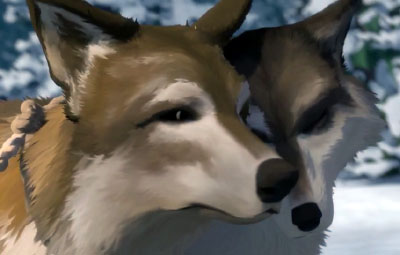 As the protagonist, White Fang is not given any narration nor human voice. We don't hear his thoughts, we only witness his situation and his reactions. The animators put a lot of good work into his face and body language to communicate this! The computer animation of the human characters varies. Grey Beaver and Smith both have... weirdly-shaped heads, almost cartoonish in design; it's mildly distracting because everyone and everything else looks normal and realistic. There are also lots of pine-filled wintery landscapes that were very well-done.
As the protagonist, White Fang is not given any narration nor human voice. We don't hear his thoughts, we only witness his situation and his reactions. The animators put a lot of good work into his face and body language to communicate this! The computer animation of the human characters varies. Grey Beaver and Smith both have... weirdly-shaped heads, almost cartoonish in design; it's mildly distracting because everyone and everything else looks normal and realistic. There are also lots of pine-filled wintery landscapes that were very well-done.
But I don't think I can fully recommend this film, it's just... largely a downer. White Fang's life is harsh; positive moments are fleeting. He never makes a single friend, and often stares forlornly into the distant sky. If you watched the trailer above, where he howls? That's the one truly happy moment in the whole thing. At the end. The trailer spoils it for you. If you don't mind the low mood, and if you're a fan of huskies or malamutes, then sure, go for it, or if you want to see a good example of animating canine emotions without the use of speech.
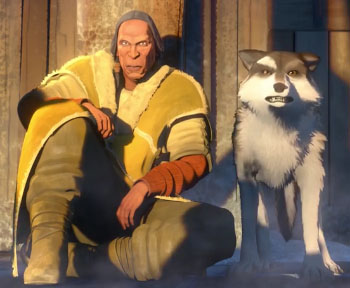 Interestingly, Jack London's White Fang, the 1906 book, was pulled into a literary debate that dragged on for several years in the early 20th century. Called the "Nature fakers controversy", it centered around how writers should (or shouldn't) depict wild animals - in other words, it was a debate about anthropomorphism! Even the Republican President of the United States, Theodore Roosevelt, weighed in on it. (Roosevelt was very interested in nature and the conservation of natural resources, though more for human use than for ecological protection.) It's a fascinating historical rabbit-hole.
Interestingly, Jack London's White Fang, the 1906 book, was pulled into a literary debate that dragged on for several years in the early 20th century. Called the "Nature fakers controversy", it centered around how writers should (or shouldn't) depict wild animals - in other words, it was a debate about anthropomorphism! Even the Republican President of the United States, Theodore Roosevelt, weighed in on it. (Roosevelt was very interested in nature and the conservation of natural resources, though more for human use than for ecological protection.) It's a fascinating historical rabbit-hole.
White Fang (the 2018 film) is currently available on Netflix, with an IMDB score of 6.9, based on 4000 votes.
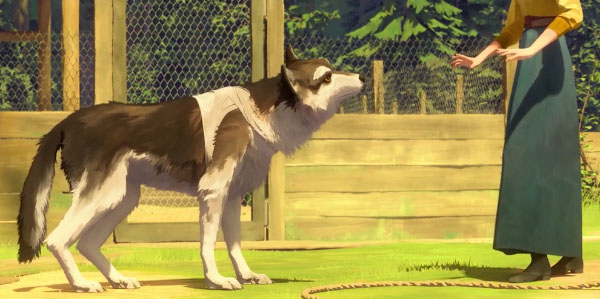
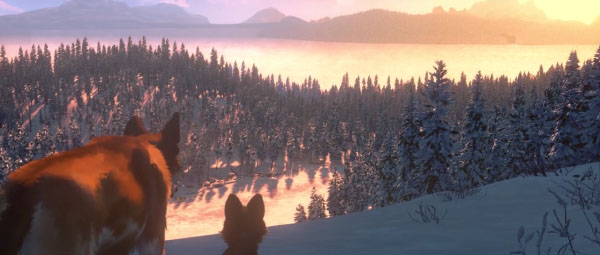
The Bears' Famous Invasion of Sicily (2019)
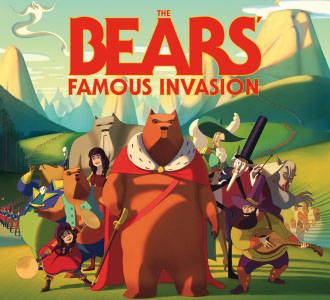 Also known as The Bears and the Invasion of Sicily, this 82-minute French-Italian production was animated by Prima Linea Productions, directed by Lorenzo Mattotti, who also co-wrote the screenplay with Jean-Luc Fromental and Thomas Bidegain. It's based on a 1945 Italian children's book by Dino Buzzati, which I haven't read, but I get the impression there have been several alterations.
Also known as The Bears and the Invasion of Sicily, this 82-minute French-Italian production was animated by Prima Linea Productions, directed by Lorenzo Mattotti, who also co-wrote the screenplay with Jean-Luc Fromental and Thomas Bidegain. It's based on a 1945 Italian children's book by Dino Buzzati, which I haven't read, but I get the impression there have been several alterations.
The film uses a framing device: a travelling entertainer named Gedeone and his young assistant take shelter in a cave, where they awaken an old bear from hibernating. In a gesture of goodwill, they tell the bear a story, and the bear tells them one in return; both halves of the same tale.
Léonce, king of the (anthropomorphic) bears, discovers his son, prince Tonio, has gone missing, and sinks into depression. Unwilling to lead his people, they starve, and in desperation make the long trek into human lands, where the Grand Duke of Sicily wages war upon them. The bears are both thwarted and helped by De Ambrosiis, the duke's recently-fired magician. Prince Tonio is found, the duke is defeated, and the bears move into Sicily, where the human-bear society prospers for many years until corruption sets in. De Ambrosiis, Prince Tonio and his best friend, a young human woman named Almerina, try to set things right.
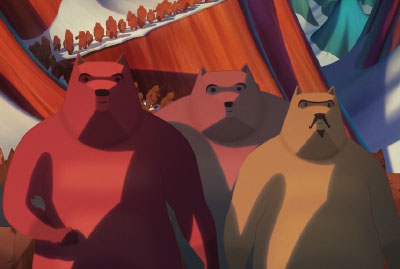 It took me a while to warm up to this film, as the character designs were rather lazy. All the bears use the same 3D shape with only small changes; their heads are tilted, four-sided pyramids. All the duke's soldiers are the same model. Crowd scenes are copy and pasted. De Ambrosiis looks like a tall, thin wooden puppet, whose chin and hat account for almost half his body length. And yet there's an aesthetic style to the thing; its use of shape, colour and atmosphere, to create a storybook tone. It works!
It took me a while to warm up to this film, as the character designs were rather lazy. All the bears use the same 3D shape with only small changes; their heads are tilted, four-sided pyramids. All the duke's soldiers are the same model. Crowd scenes are copy and pasted. De Ambrosiis looks like a tall, thin wooden puppet, whose chin and hat account for almost half his body length. And yet there's an aesthetic style to the thing; its use of shape, colour and atmosphere, to create a storybook tone. It works!
By the end of the film, I was fine with it. Partially this was helped by the story taking some unexpected turns along the way. Surprisingly, there is no main protagonist. Léonce is a well-respected but poor leader. Tonio has some issues. I liked Almerina a lot, probably because she's the least cartoony-looking. But it's De Ambrosiis who's got the best story arc. He starts off deeply flawed, and gradually redeems himself. Even though he's a secondary character, I found him to be the most interesting. I had the same experience watching The Bad Guys - I enjoyed Snake's character much more than Wolf's, though I suspect I'm in the minority. (I just looked at it again, and egads, the CalArts bean face really is everywhere.)
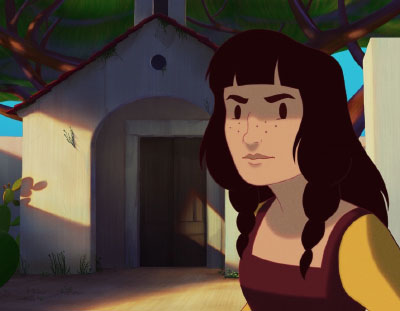
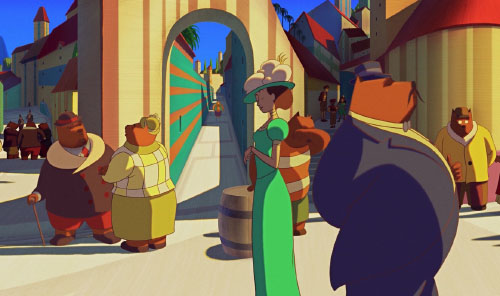 Of all the films I'm reviewing here today, I think Bears has the most appeal.
Of all the films I'm reviewing here today, I think Bears has the most appeal.
IMDB gives it a score of 7.1, based on 1830 votes. Annoyingly, not only is there no English dub, I can't find it for streaming in North America; it's available in France and Italy. The copy I watched was pirated, in French with English subtitles. If you go looking for it, you may have better luck using its French title, La fameuse invasion des ours en Sicile.
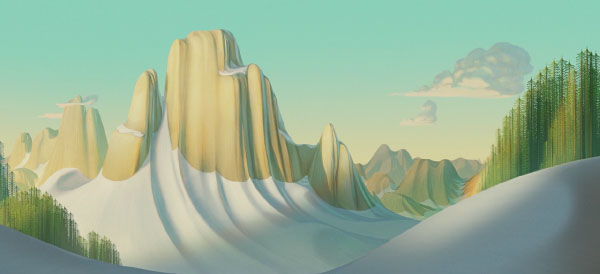
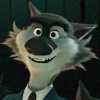
Comments
Post new comment